Indian coral tree, Coral Tree
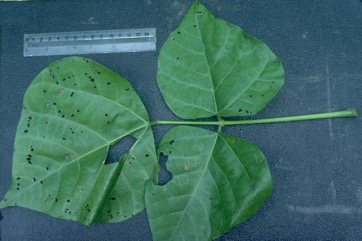
A tropical plant. It is native from India to the Philippines and the Pacific. It mostly grows naturally along the dunes very close to the coast but is transplanted as an ornamental. It will grow up to 900 m altitude. It has been recorded up to 2,200 m above sea level in PNG. It is tolerant to salt. It can tolerate drought. It needs full sun. It can grow in a wide range of soils and soil pH values from 4.5-8.0. It is a nitrogen fixing tree so can grow on poor soils. It can grow in arid places. It suits hardiness zones 11-12. In Yunnan.
Also known as:
'atae, Badisa, Badita, Bangaro, Baridamu, Belendoong, Berebedhi, Butsu daavi, Chengkering, Citong, Dadap aykam, Dadap belang, Dadap blendung, Dap-dap, Dedap, Drala, Erabadu, Faiy-kurehi, Far-tuah, Galala itam, Gatae, Gate, Harivana, In-kathit, Kalayana-murikku, Kaliyanamurukku, Kathit-phyu, Mandar, Mandara, Mandaram, Milimbit, Modugu, Nara, Natae, Netae, Ngatae, Paar, Palita mandar, Palita, Panaraweo, Panervo, Panga, Pangara, Pangra, Parepein, Parijata, Pinle-kathit, Raar, Tawng lang, Tawng puak, Thethek, Thong-laang-laai, Thorny Tong, Tiger's claw, Varjipe, Vong nem, Waigunda, Weeku, Wiliwili hole
Synonyms
- Chirocalyx candolleanus Walp.
- and others Corallodendron divaricatum (Moc. & Sesse) Kuntze
- Corallodendron orientale (L.) Kuntze
- Erythrina corallodendon var. orientalis L.
- Erythrina indica Lam.
- Erythrina indica var. orientalis (L.) Miller
- Erythrina lithosperma Bl. ex Miq.
- Erythrina orientalis (L.) Merrill
- Erythrina parcellii hort.
- Tetradapa javanorum Osbeck
- and others
Edible Portion
- Seeds, Leaves, Vegetable, Pods, Flowers
Where does Indian coral tree grow?
Found in: Africa, American Samoa, Andamans, Asia, Australia, Bangladesh, British Indian Ocean Terr., BIOT, Cambodia, Cape Verde, China, East Africa, East Timor, Egypt, Fiji, Guam, Haiti, Hawaii, Himalayas, India, Indochina, Indonesia, Japan, Kiribati, Laos, Madagascar, Malaysia, Maldives, Mariana Islands, Marquesas, Marshall Islands, Micronesia, Myanmar, Nigeria, North Africa, Northeastern India, Pacific, Palau, Papua New Guinea, PNG, Philippines, Pohnpei, Rotuma, Ruukyu, Samoa, Sao Tome and Principe, SE Asia, Senegal, Sri Lanka, Sudan, Taiwan, Tanzania, Thailand, Timor-Leste, Tonga, Uganda, United States, Vanuatu, Vietnam, Wallis & Futuna, West Africa, Yap
Notes: There are 108 Erythrina species.
Status: The tree occurs in many lowland areas of Papua New Guinea, but the leaves are only eaten by Sepik people at present.
Growing Indian coral tree, Coral Tree
Cultivation: Trees can be grown from seed. Seed will remain viable for several years. Trees do not breed true from seed. Cuttings also grow easily. Large cuttings can be used.
Edible Uses: The young leaves are eaten cooked. They are added to soups, stews and curries. The seeds are eaten after boiling or roasting. The young tender pods are boiled and eaten. The roots of seedlings less than 45 cm high are roasted and eaten. CAUTION Some similar coral trees contain alkaloids and are used as medicine. The seeds are poisonous raw.
Production: It is fast growing. It can grow 1.5 m each year. Trees can live for 100 years.
Nutrition Info
per 100g edible portion| Edible Part | Energy (kcal) | Protein (g) | Iron (mg) | Vitamin A (ug) | Vitamin c (mg) | Zinc (mg) | % Water |
|---|---|---|---|---|---|---|---|
| Leaves | 69 | 5 | 4.1 | - | - | 0.9 | 78.1 |
Indian coral tree, Coral Tree Photos

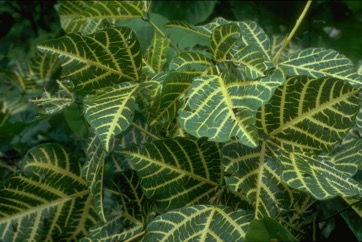
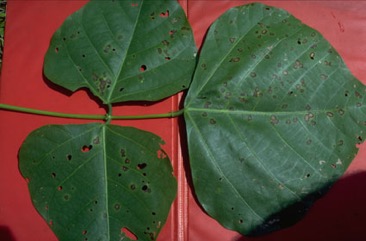
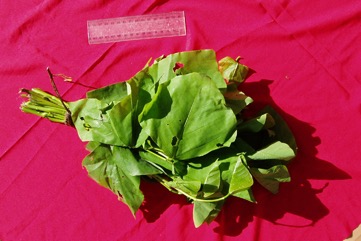
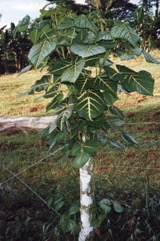
References
Ambasta, S.P. (Ed.), 2000, The Useful Plants of India. CSIR India. p 205 (var. orientalis)
Barwick, M., 2004, Tropical and Subtropical Trees. A Worldwide Encyclopedic Guide. Thames and Hudson p 166
Bodkin, F., 1991, Encyclopedia Botanica. Cornstalk publishing, p 403
Borrell, O.W., 1989, An Annotated Checklist of the Flora of Kairiru Island, New Guinea. Marcellin College, Victoria Australia. p 91 (var. orientalis)
Bourke, R. M., Altitudinal limits of 230 economic crop species in Papua New Guinea. Terra australis 32.
Brickell, C. (Ed.), 1999, The Royal Horticultural Society A-Z Encyclopedia of Garden Plants. Convent Garden Books. p 417
Burkill, H. M., 1985, The useful plants of west tropical Africa, Vol. 2. Kew.
Burkill, I.H., 1966, A Dictionary of the Economic Products of the Malay Peninsula. Ministry of Agriculture and Cooperatives, Kuala Lumpur, Malaysia. Vol 1 (A-H) p 964
Cabalion, P. and Morat, P., 1983, Introduction le vegetation, la flore et aux noms vernaculaires de l'ile de Pentcoste (Vanuatu), In: Journal d'agriculture traditionnelle et de botanique appliquee JATBA Vol. 30, 3-4
Cooper, W. and Cooper, W., 2004, Fruits of the Australian Tropical Rainforest. Nokomis Editions, Victoria, Australia. p 210
Cowie, I, 2006, A Survey of Flora and vegetation of the proposed Jaco-Tutuala-Lore National Park. Timor-Lests (East Timor) www.territorystories.nt/gov.au p 47 (var. orientalis)
Cribb, A.B. & J.W., 1976, Wild Food in Australia, Fontana. p 106 (var. orientalis)
Cundall, P., (ed.), 2004, Gardening Australia: flora: the gardener's bible. ABC Books. p 563
Elevitch, C.R.(ed.), 2006, Traditional Trees of the Pacific Islands: Their Culture, Environment and Use. Permanent Agriculture Resources, Holualoa, Hawaii. p 329
Elliot, W.R., & Jones, D.L., 1984, Encyclopedia of Australian Plants suitable for cultivation. Vol 3. Lothian. p 488
Engel, D.H., & Phummai, S., 2000, A Field Guide to Tropical Plants of Asia. Timber Press. p 80
Etherington, K., & Imwold, D., (Eds), 2001, Botanica's Trees & Shrubs. The illustrated A-Z of over 8500 trees and shrubs. Random House, Australia. p 291
Facciola, S., 1998, Cornucopia 2: a Source Book of Edible Plants. Kampong Publications, p 104
Fl. Ned. Ind. 1(1):209. 1855 (non Blume ex Hassk. 1825) an illegitimate later homonym (ICBN Art. 53) that is unavailable for use (As Erythrina lithosperma)
Franklin, J., Keppel, G., & Whistler, W., 2008, The vegetation and flora of Lakeba, Nayau and Aiwa Islands, Central Lau Group, Fiji. Micronesica 40(1/2): 169–225, 2008
French, B.R., 1986, Food Plants of Papua New Guinea, A Compendium. Asia Pacific Science Foundation p 86
Grubben, G. J. H. and Denton, O. A. (eds), 2004, Plant Resources of Tropical Africa 2. Vegetables. PROTA, Wageningen, Netherlands. p 561
Hearne, D.A., & Rance, S.J., 1975, Trees for Darwin and Northern Australia. AGPS, Canberra p 56
Hedrick, U.P., 1919, (Ed.), Sturtevant's edible plants of the world. p 294 (As Erythrina indica)
Henty, E.E., 1980, Harmful Plants in Papua New Guinea. Botany Bulletin No 12. Division Botany, Lae, Papua New Guinea. p 88,
Herb. amb. 10. 1754
Hibbert, M., 2002, The Aussie Plant Finder 2002, Florilegium. p 95
Interpr. Herb. amboin. 276. 1917 (var. orientalis)
Jadhav, R., et al, 2015, Forest Foods of Northern Western Ghats: Mode of Consumption, Nutrition and Availability. Asian Agri-History Vol. 19, No. 4: 293-317
Kar, A., et al, 2013, Wild Edible Plant Resources used by the Mizos of Mizoram, India. Kathmandu University Journal of Science, Engineering and Technology. Vol. 9, No. 1, July, 2013, 106-126
Krishen P., 2006, Trees of Delhi, A Field Guide. DK Books. p 205
Lazarides, M. & Hince, B., 1993, Handbook of Economic Plants of Australia, CSIRO. p 96
Leach, G. J., 1988, Bush Food Plants of the Blackwater and Karawari Rivers Area, East Sepik Province, Papua New Guinea. Science in New Guinea 14(2). p 101 (As Erythrina indica)
Levitt, D., 1981, Plants and people. Aboriginal uses of plants on Groote Eylandt. Australian Institute of Aboriginal Studies, Canberra. p 114 (var. orientalis)
Liefting, A., et al, Samoan plant names. http://en.wikipedia.org
Liu, Yi-tao, & Long, Chun-Lin, 2002, Studies on Edible Flowers Consumed by Ethnic Groups in Yunnan. Acta Botanica Yunnanica. 24(1):41-56
Llamas, K.A., 2003, Tropical Flowering Plants. Timber Press. p 220
Lord, E.E., & Willis, J.H., 1999, Shrubs and Trees for Australian gardens. Lothian. p 54
Martin, F.W. & Ruberte, R.M., 1979, Edible Leaves of the Tropics. Antillian College Press, Mayaguez, Puerto Rico. p 82, 199
Menninger, E.A., 1977, Edible Nuts of the World. Horticultural Books. Florida p 94
Milow, P., et al, 2013, Malaysian species of plants with edible fruits or seeds and their evaluation. International Journal of Fruit Science. 14:1, 1-27
Monsalud, M.R., Tongacan, A.L., Lopez, F.R., & Lagrimas, M.Q., 1966, Edible Wild Plants in Philippine Forests. Philippine Journal of Science. p 487 (As Erythrina orientalis)
Mot So Rau Dai an Duoc O Vietnam. Wild edible Vegetables. Ha Noi 1994, p 158 (As Variegata orientalis)
Ochse, J.J. et al, 1931, Vegetables of the Dutch East Indies. Asher reprint. p 388
Ogle, B. M., et al, 2003, Food, Feed or Medicine: The Multiple Functions of Edible Wild Plants in Vietnam. Economic Botany 57(1): 103-117 (As Erythrina orientalis)
Peekel, P.G., 1984, (Translation E.E.Henty), Flora of the Bismarck Archipelago for Naturalists, Division of Botany, Lae, PNG. p 249, 246
Pham-Hoang Ho, 1999, An Illustrated Flora of Vietnam. Nha Xuat Ban Tre. p 938
Phon, P., 2000, Plants used in Cambodia. © Pauline Dy Phon, Phnom Penh, Cambodia. p 279
Plants of Haiti Smithsonian Institute http://botany.si.edu/antilles/West Indies
Royal Botanic Gardens, Kew (1999). Survey of Economic Plants for Arid and Semi-Arid Lands (SEPASAL) database. Published on the Internet; http://www.rbgkew.org.uk/ceb/sepasal/internet [Accessed 28th April 2011]
Sahni, K.C., 2000, The Book of Indian Trees. Bombay Natural History Society. Oxford. p 88
Seidemann J., 2005, World Spice Plants. Economic Usage, Botany, Taxonomy. Springer. p 148
Selvam, V., 2007, Trees and shrubs of the Maldives. RAP Publication No. 2007/12 p 86
Singh, H.B., Arora R.K.,1978, Wild edible Plants of India. Indian Council of Agricultural Research, New Delhi. p 81
Staples, G.W. and Herbst, D.R., 2005, A tropical Garden Flora. Bishop Museum Press, Honolulu, Hawaii. p 316
Sujanapal, P., & Sankaran, K. V., 2016, Common Plants of Maldives. FAO & Kerala FRI, p 121
Swaminathan, M.S., and Kochnar, S.L., 2007, An Atlas of Major Flowering Trees in India. Macmillan. p 110
Tanaka, Y & Van Ke, N., 2007, Edible Wild Plants of Vietnam. Orchid Press. p 78 (As Erythrina orientalis)
Terra, G.J.A., 1973, Tropical Vegetables. Communication 54e Royal Tropical Institute, Amsterdam, p 45 (Also as Erythrina lithosperma)
Thitiprasert, W., et al, 2007, Country report on the State of Plant Genetic Resources for Food and Agriculture in Thailand (1997-2004). FAO p 95
Topp, J. M. W., 1988, An Annotated Check List of the Flora of Diego Garcia, British Ocean Territory. Atoll Research Bulletin No. 313 (Introduced and possibly rare)
Trimanto, & Hapsari L., 2016, Botanical survey in thirteen montane forests of Bawean Island Nature Reserve, East Java Indonesia: Conservation status, bioprospecting and potential tourism. Biodiversitas 17: 832-846.
Valder, P., 1999, The Garden Plants of China. Florilegium. p 284
Verdcourt, B., 1979, Manual of New Guinea Legumes. Botany Bulletin No 11, Division of Botany, Lae, Papua New Guinea. p 425
Wild edible plants of Himachal Pradesh
World Checklist of Useful Plant Species 2020. Royal Botanic Gardens, Kew
www.worldagroforestrycentre.org/treedb/ (As Erythrina indica)
Xu, Z., Tao, G. & Tan, J., 1988, Tropical Wild Flowers and Plants in Xishuangbanna, Agricultural Publishing House. photo 9 (As Erythrina lithosperma)
Xu, You-Kai, et al, 2004, Wild Vegetable Resources and Market Survey in Xishuangbanna, Southwest China. Economic Botany. 58(4): 647-667. (As Erythrina lithosperma)
Yuncker, T.G., 1959, Plants of Tonga, Bernice P. Bishop Museum, Hawaii, Bulletin 220. p 146